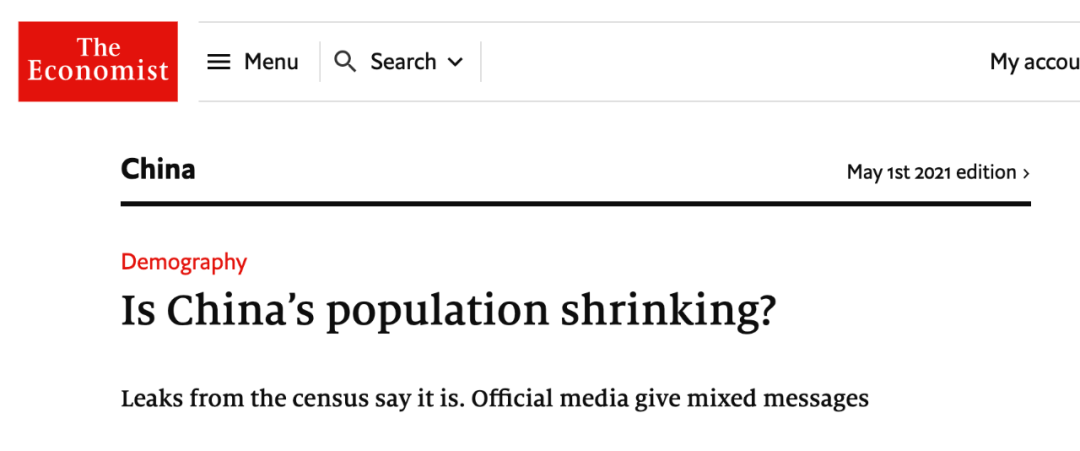
昨天,国家公布了一项重磅数据,那就是2020年的第七次人口普查的基本数据。
其中最重要的数据如下:
全国人口共141178万人,与2010年(第六次人口普查)的133972万人相比,增加7206万人。
官方对该数据的结论为:
我国人口10年来继续保持低速增长态势
。
我还记得上个月末,海外盛传“中国人口下降”的预言,各大外媒也是报道得很嗨:
《伦敦金融时报》首先“开炮”:

China set to report first population decline in five decades(Officials are preparing a response to census data that should have been released weeks ago)
译:中国准备公布50年内首次人口下降(官方正在准备回应一份推迟了数周的人口普查数据)
《经济学人》杂志“紧随其后”:

Is China's population shrinking?(Leaks from the census say it is. Official media give mixed messages)
译:中国人口“缩小”了吗?(人口普查泄露的信息确认这点,但官方媒体却含糊不清)。
《财富》杂志“打边鼓”:

Is China's population growing or shrinking? It's a touchy topic for Beijing.
译:中国人口增了还是降了?是个敏感话题。
这次中国官方数据一出,让市面上这些“预测”不攻自破了。
你可能会问,人口下降不挺好?那么多人不是拖累国家嘛?为啥“增”比“降”好?
中国经济目前全世界一枝独秀,背后最根本的因素就是
人口红利
(demographic dividend)。

而人口下降就意味着人口红利消失、经济发展优势不再,这对于逐利性的资本来说,就会出走到更有人口红利的国家。
所以,人口数据是一个国家经济的风向标,意义重大。
这次国家公布最新人口数字,无疑给国际资本吃了颗定心丸:中国依然是世界第一人口大国,这个基本事实木有变。
这次中国公布人口最新数据后,我观察了一下,美国的彭博社 Bloomberg 是首个进行报道的外媒:

先看标题,虽然不说“人口下降”了,但感觉依然带着一丝“灰色滤镜”:
China’s Population Growth Slows Amid Declining Births
译:在出生率下降的背景中,中国人口增长放缓。
无论是这个
slow
,还是
declining birth
,无不营造出一种“萧条”的氛围。
我们来看一下文章里最重要的开头部分:
China’s population growth slowed, with the nation becoming older and more urbanized, reshaping the economy’s
demographic landscape
.
译:随着中国的老龄化和城镇化,中国人口增长放缓,重塑了这个国家的人口结构。
There were 1.412 billion people in China last year, the National Bureau of Statistics said Tuesday in Beijing in its once-a-decade
census
report. In 2017, the government forecast a population of 1.42 billion by 2020, peaking at 1.45 billion in 2030. The annual average growth of 0.53% in the past decade was the slowest since 1953.
译:周二,中国国家统计局在北京公布其十年一度的人口报告数据:去年中国的人口数字为14.12亿人。2017年,政府预测2020年人口数字为14.2亿,在2030年达到峰值的14.5亿。过往年平均增速为0.53%,为1953年以来的最低。

这里有两个人口统计学的术语:
1.demographic landscape
(/ˌdeməˈɡræfɪk/ /ˈlændskeɪp/)
demographic 是“人口统计的”,前缀demo-表示“人口”,graphic 表示“图表”,引申为“统计”;
landscape 原义指“景观”,这里表示“面貌”、“图景”,故 demographic landscape 可以翻译为“人口结构”。
2.census
(/ˈsensəs/ )
这个词表示“人口普查”。
造句:
The census is taken one time every ten years in our country.
译:我国每10年一次人口普查。
彭博社这篇文章虽然没有否认中国人口1.4亿以及增长的事实,但似乎一直在强调“低速”和“放缓”。
不过,跟《纽约时报》相比,彭博社还算客观了。

《纽约时报》的用词感觉“敌意”更强,先看主标题:
China's long-term Time Bomb: Falling births stunt population growth.
译:中国的长期定时炸弹:出生率降低阻碍人口增长。
留意这里的
time bomb
(定时炸弹)、
stunt
(vt.阻碍...的发展)的用词。
副标题:
...the lowest number of births since 1961, providing fresh evidence of a looming demographic crisis that could complicate Beijing's ambition.
译:1961年来的最低出生率,预示着人口危机不断逼近,这也给北京的宏伟目标增加了难度。
这里的
fresh evidence
(新证据);
looming demographic crisis
(不断逼近的人口危机);
complicate
(vt.使...复杂化),勾勒出肃杀氛围。
看来对于“中国人口”话题,外媒这“滤镜”恐怕要一直戴下去了。
当然,保持人口世界第一,并持续增长是good news,但“出生率降低”(falling births)、“人口增长放缓”(slow population growth)、“老龄化问题”(aging problem),虽然没有外媒说得那么危言耸听,也是需要我们正视和解决的。




